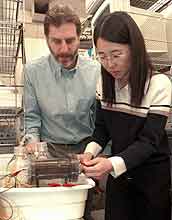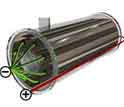|

Press Release 04-021
Fuel-Cell Microbes' Double Duty: Treat Water, Make Energy

NSF 'sugar' grant supports single-chamber prototype fed by wastewater
February 23, 2004
ARLINGTON, Va.--Something big may be brewing on the sewage-treatment circuit thanks to a new design that puts bacteria on double duty - treating wastewater and generating electricity at the same time.
The key is an innovative, single-chambered microbial fuel cell. The prototype is described in the online version of the journal Environmental Science & Technology (http://pubs.acs.org/journals/esthag/); the article will also appear in a future print version of ES&T.
A fuel cell operates akin to a battery, generating electricity from a chemical reaction. But instead of running down unless it's recharged, the cell receives a constant supply of fuel from which electrons can be released. Typical fuel cells run off of hydrogen. In a microbial fuel cell, bacteria metabolize their food—in this case, organic matter in wastewater—to release electrons that yield a steady electrical current.
The single-chambered prototype, developed by researchers at Pennsylvania State University with support from the National Science Foundation (NSF), allows the process to work efficiently in wastewater.
In their paper, the researchers suggest that the improved design could usher in a "completely new approach" to wastewater treatment: "If power generation in these systems can be increased, microbial fuel cell technology may provide a new method to offset wastewater treatment plant operating costs, making advanced wastewater treatment more affordable for both developing and industrialized nations."
An $87,000 grant from NSF's Small Grants for Exploratory Research (SGER) program supported the project. Such SGER—called "sugar"—grants foster small-scale, innovative preliminary research on untested, novel ideas. They also sometimes fund quick-response research on natural disasters and other unanticipated events or support research to "catalyze" emerging innovations.
The single-chambered microbial fuel cell is essentially a plexiglass cylinder about the size of a soda bottle. Inside are eight graphite anodes (or negative electrodes), upon which the bacteria attach, and a hollow central cathode (or positive electrode). Electrons flow along a circuit wired from the anode to the cathode.
A steady flow of wastewater pumped into the chamber feeds the bacteria. Bacterial digestion of the wastewater's organic matter unleashes electrons into the electrical circuit and positively charged hydrogen ions into the solution. Those ions reduce the solution's oxygen demand, a key goal of wastewater treatment. The hydrogen ions also pass through a proton-exchange membrane to reach the cathode. Meanwhile, a hollow tube within the cylinder contains the cathode, which is exposed to air. At the cathode, oxygen from the air, hydrogen ions coming through the membrane and the electrons coming down the circuit combine to create water.
In other microbial fuel cells, microbes have been fed glucose, ethanol and other fuels, but, according to Bruce Logan, the Penn State professor of environmental engineering who leads the project, "Nobody has ever tried this with domestic wastewater. We're using something thought to be completely useless."
The single-chamber design is important, he said, because it facilitates a "continuous flow-through system," a design consistent with existing treatment systems.
By introducing air passively through the tube within the cathode layer, this model also greatly reduces the need for more aggressive – and energy-demanding – aeration schemes to treat the wastewater. Thus, as it creates electricity, it also reduces the need for it.
Each year in the United States, about 33 billion gallons of domestic wastewater is treated at cost of $25 billion; much of it pays for energy. If the microbial fuel cell can be applied on a larger scale, it could significantly reduce the energy costs of wastewater treatment.
It's not a small "if."
"We've got to make it cheaper," said Logan. "We can't afford to use graphite rods on the anodes, Nafion as the proton-exchange membrane, and platinum on the carbon cathode. But we're already making progress on that. Substantially cheaper systems are just around the corner."
Meanwhile, amid the slime on the anodes, countless and various bacteria play distinctive roles in the breakdown of the wastewater and creation of electricity.
"This is a whole community reaction," said Logan. "We're just beginning to appreciate and understand the complex bacterial community needed to generate electricity from wastewater."
Bruce Logan, Hong Liu and Stephen Grot recently won a Popular Mechanics Breakthrough Award for their work on microbe-driven fuel cells.
-NSF-
Pennsylvania State University news release: www.psu.edu/ur/2004/microbfuel.html

Media Contacts
Sean Kearns, NSF (703) 292-7963 skearns@nsf.gov
Program Contacts
Thomas D. Waite, NSF (703) 292-7499 twaite@nsf.gov
Principal Investigators
Bruce E. Logan, Pennsylvania State University (818) 863-7908 blogan@psu.edu

The National Science Foundation (NSF) is an independent federal agency that supports fundamental research and education across all fields of science and engineering. In fiscal year (FY) 2009, its budget is $9.5 billion, which includes $3.0 billion provided through the American Recovery and Reinvestment Act. NSF funds reach all 50 states through grants to over 1,900 universities and institutions. Each year, NSF receives about 44,400 competitive requests for funding, and makes over 11,500 new funding awards. NSF also awards over $400 million in professional and service contracts yearly.
 Get News Updates by Email Get News Updates by Email
Useful NSF Web Sites:
NSF Home Page: http://www.nsf.gov
NSF News: http://www.nsf.gov/news/
For the News Media: http://www.nsf.gov/news/newsroom.jsp
Science and Engineering Statistics: http://www.nsf.gov/statistics/
Awards Searches: http://www.nsf.gov/awardsearch/
| 



